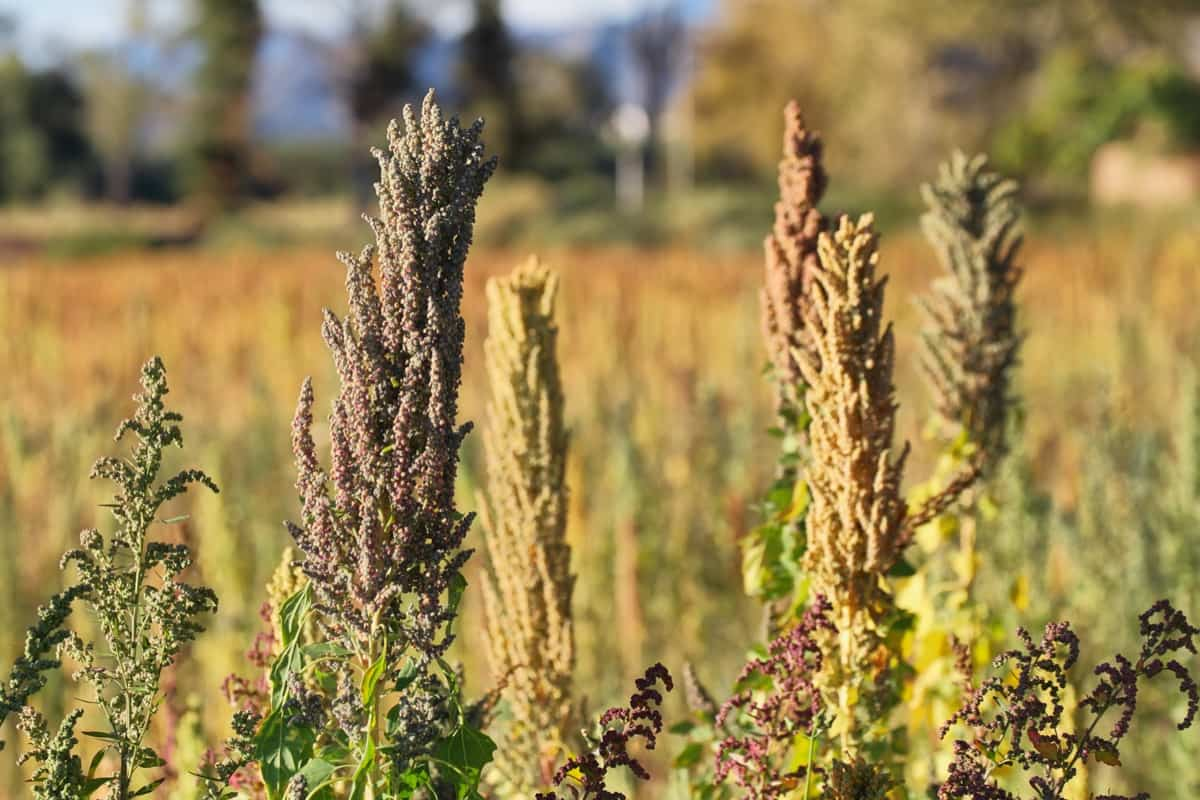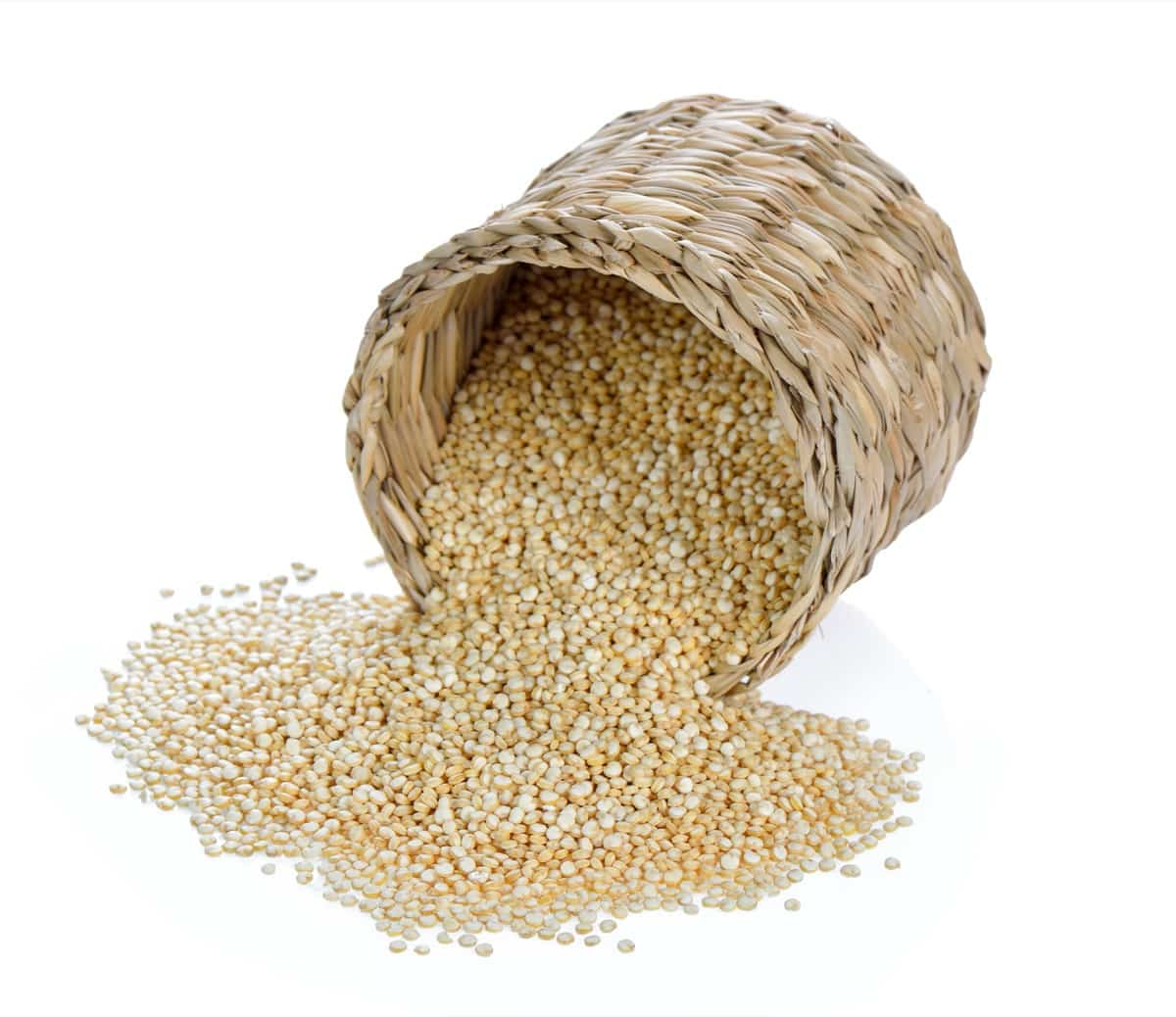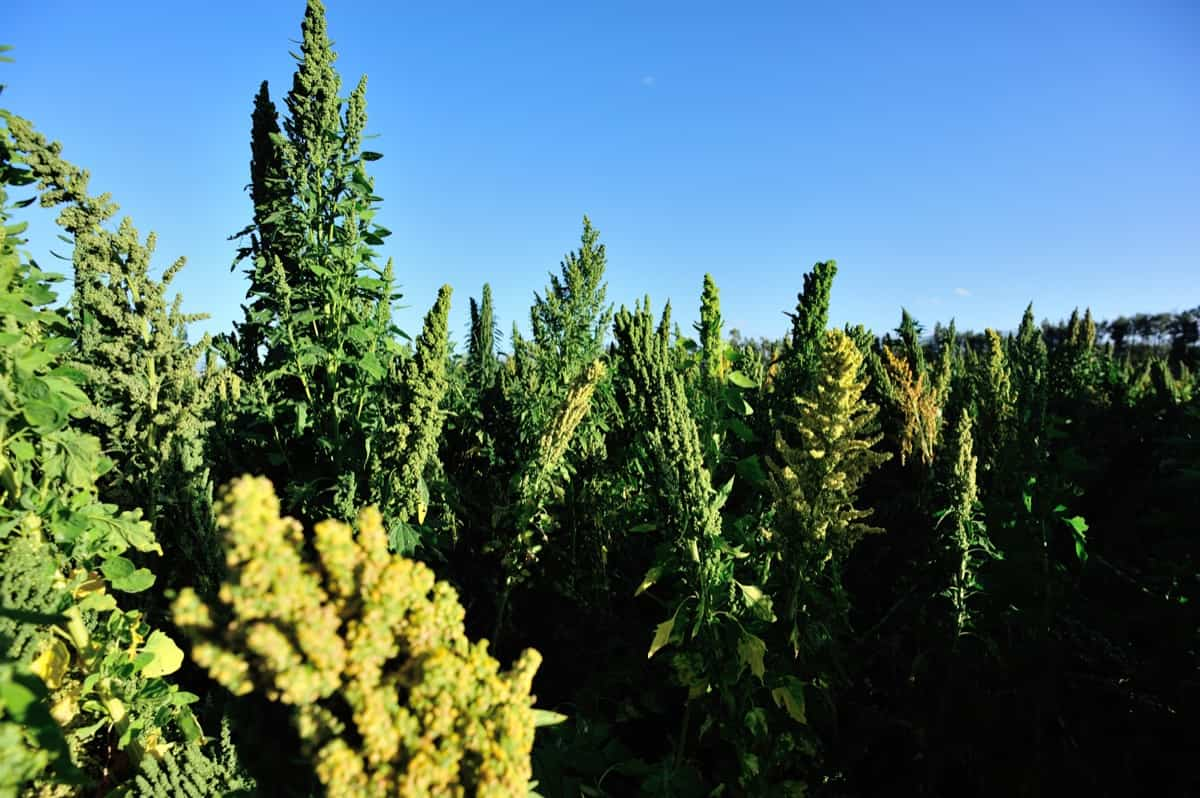Quinoa farming has gained popularity due to its nutritional value and adaptability to various climates. This cost and profit analysis provides insights into the economics of cultivating quinoa on a one-acre farm. By examining the expenses involved in the production, including inputs, labor, equipment, and potential revenue streams, this project report aims to evaluate the profitability of quinoa farming and inform prospective farmers. Let’s check out the 1-acre project report of Quinoa farming below.

What is Quinoa Farming?
Quinoa is an herbaceous plant that can grow up to 3 meters tall. It has a thick cylindrical stalk, alternate leaves varying in shape, and small apetalous flowers clustered in racemose inflorescences. The plant produces tiny seeds in achene fruits, which come in various colors. Quinoa has a deep taproot that enhances its resistance to drought, and it is also frost-resistant, salt-tolerant, and can thrive in poor soils.
Market and Demand for Quinoa Farming
The rising demand for quinoa is driven by its nutritional value and associated health benefits, leading to increased prices for the product. The quinoa market has experienced significant growth due to its popularity among health-conscious consumers. However, limited production due to specific farming requirements challenges its expansion. Despite this limitation, exports are crucial in driving the crop’s market growth.
The global quinoa seeds market is expected to achieve a 5.4% compound annual growth rate (CAGR) during the forecast period. Quinoa’s gluten-free nature and high fiber content make it highly sought after, particularly for food products like pasta, noodles, and bread. The number of countries engaged in quinoa production has increased, resulting in a boost in commercial-scale cultivation. The higher market price has attracted new players into quinoa production, including Bolivian taxi drivers and European farmers.
Best High-Yielding Variety for Quinoa Farming
Biobio, originating from Chile, is a red variety of quinoa with white seeds. It has a shorter growing season, a high yield, and smaller seeds than other varieties. Bright Brilliant is favored for its ornamental appeal, with colors ranging from orange, pink, burgundy, and white to yellow.
It grows up to 4 feet tall. Buffy, a cross with Oro de Valle quinoa, is buff-colored, exhibits strong stems, and offers a high yield. Cherry Vanilla produces cream to pink flower clusters and serves as an ornamental border or grain crop at heights of 3 to 5 feet. French Vanilla is 6 to 7 feet tall, featuring uniform broadheads and white or buff seeds, with excellent yields.
Best Package and Practices for Quinoa Farming
Growing Zones: Quinoa can be cultivated in USDA hardiness zones 4 through 10. Regions below zone 4 experience prolonged periods of extreme cold, which are unsuitable for quinoa. The crop requires 90-120 days to mature, so ensuring the growing season is long enough to accommodate its growth is essential. Quinoa thrives in regions where summer temperatures do not exceed 95℉ in June when flowering begins. While mature quinoa can withstand some frost, a freeze during the flowering stage may render it sterile.
Sun Requirements: Full sun is necessary for proper quinoa growth, although providing shade during the hottest day is beneficial.
Soil Requirements: Quinoa is adaptable to various soil types but thrives best in fertile, well-draining loam. Adding organic fertilizer to the soil ensures abundant nutrients to support plant growth. Quinoa is considered a nutrient-demanding crop. The ideal soil pH ranges from slightly acidic to neutral (6.0-7.5). Adjusting the pH can be achieved by incorporating peat moss or organic mulches.
Planting Time: It is advisable to wait until after the last spring frost to plant quinoa seedlings. The seeds germinate best in soil temperatures around 60℉. Planning for a harvest requires considering the 90-120 day growth period, so timing is crucial.
Planting Quinoa: After the final frost, prepare the soil by loosening and amending it. Sow quinoa seeds in even rows, with approximately one gram of seeds covering a 50-foot row. The seeds should be covered with soil. Keep the soil consistently moist to encourage germination, which typically takes 4 to 5 days. Replant any areas that have not sprouted after one week.
Spacing: Once the seedlings reach a height of four inches, gradually thin them out, leaving 18 inches of space between each plant. Quinoa plants grow tall, reaching up to 4 feet in dry climates and up to 8 feet with sufficient water.
Watering: Regular watering is crucial for quinoa’s germination and early growth during the initial stages. The soil should remain evenly moist. As the plants mature, water during dry spells, allowing a few inches of soil to dry between watering. Approximately 10 inches of water is required during the growth period.
Fertilizing: While traditional cultivation in the Andean region does not involve fertilizer, quinoa responds well to nitrogen fertilizers in regions with different soil fertility. Care should be taken not to overapply nitrogen, as excessive amounts can decrease yields. A balanced 10-10-10 fertilizer during planting and side dressing with nitrogen fertilizer 4 to 6 weeks later is recommended.
In case you missed it: Frequently Asked Questions About Quinoa Farming

Mulching: Add several inches of mulch around the quinoa plants to suppress weed growth. Mulching also helps retain soil moisture and regulate soil temperature.
Weeding: Weeds can impede the growth of quinoa, especially during its early stages. Mulching is an effective method to control weeds, but it is important to correctly identify and differentiate quinoa from similar-looking weeds like lamb’s quarter.
Companion Plants: Quinoa thrives alongside beans, corn, dill, garlic, mint, and rue. However, it is not recommended to grow quinoa with tomatoes.
Diseases and Pests: While quinoa grown in its native regions experiences minimal pest and disease issues, growers in other areas may encounter common problems. Natural methods and prevention are typically employed, as no pesticides are approved for use on quinoa.
- Aphids: Use neem oil or introduce beneficial predators like lady beetles and green lacewing larvae.
- Cabbage Loopers: Rotate crops, manually remove them, and encourage predators. Sprays like spinosad, pyrethrin, and BTK can help control larger infestations.
- Downy Mildew: Increase plant spacing, avoid overhead watering, and apply a garlic spray or sprinkle baking soda on plants to combat the fungus.
- Flea Beetles: Use row covers and garlic sprays, or create traps with petroleum jelly on cardboard.
- Lygus Bugs: Introduce beneficial predators like parasitoid wasps and crab spiders.
Harvesting and Storing
Quinoa is ready for harvest 90-120 days after planting when the seeds become difficult to dent with a fingernail. Please wait until the plants begin shedding their leaves, then bend the seed heads into a bucket and cut them off. Strip the seeds from the stalks, remove debris, and dry them on a screen.
1-Acre Project Report of Quinoa Farming
The components included in the cost of cultivation for amaranth millet farming typically consist of seeds, land preparation, fertilizers, organic manure/compost, irrigation, weed management, pest and disease control, harvesting and threshing, post-harvest management, and miscellaneous expenses.
| Components | Cost (USD) |
| Quinoa Seeds | $50 |
| Land Rent | $100 |
| Soil Preparation | $50 |
| Fertilizers | $100 |
| Irrigation | $50 |
| Labor (including planting, maintenance, and harvesting) | $150 |
| Equipment Rental | $50 |
| Miscellaneous Expenses | $50 |
| Total | $550 |
Total Returns and Net from 1Acre Quinoa Farming
- Cost of cultivation: $500 to $550
- Yield per acre: 2 to 3 tonnes (or 2,000 to 3,000 kilograms)
- Price of 1 kilogram of quinoa: $2.7
Calculate the net returns for both yield scenarios:
- For a yield of 2 tonnes (2,000 kilograms): Total revenue = Yield per acre * Price per kilogram Total revenue = 2,000 kg * $2.7/kg = $5,400
- Net returns = Total revenue – Cost of cultivation Net returns = $5,400 – $500 = $4,900 (minimum) Net returns = $5,400 – $550 = $4,850 (maximum)
- For a yield of 3 tonnes (3,000 kilograms): Total revenue = Yield per acre * Price per kilogram Total revenue = 3,000 kg * $2.7/kg = $8,100
- Net returns = Total revenue – Cost of cultivation Net returns = $8,100 – $500 = $7,600 (minimum) Net returns = $8,100 – $550 = $7,550 (maximum)
- Therefore, the estimated net returns from 1-acre quinoa farming range from $4,900 to $7,600, depending on the Yield per acre.
Challenges and Risks in Quinoa Farming
Quinoa farming faces challenges such as adapting to different climates and growing conditions, managing pests and diseases without approved pesticides, ensuring proper irrigation and water management, and addressing potential issues like frost damage during flowering. Maintaining soil fertility, preventing weed competition, and addressing market fluctuations and price volatility are important considerations for successful quinoa cultivation.
In case you missed it: 1-Acre Project Report of Amaranth Millet/Grain Farming: Production Economics, Cultivation Cost and Profit

Conclusion
1-acre quinoa farming can be a profitable venture with careful planning and implementation. Despite the initial investment in seeds, equipment, labor, and irrigation, the high demand for quinoa and its potential market value offers an opportunity for significant returns. However, it is crucial to consider the associated risks and challenges to ensure successful and sustainable quinoa production.
- Feed Your Flock for Less: Top 10 Tips to Save on Chicken Feed
- Ultimate Guide to Ossabaw Island Hog: Breeding, Raising, Diet, and Care
- Hatching Answers: The Top 10 Reasons Your Chickens Aren’t Laying Eggs
- Eggs and Economics: Breaking Down the Cost of Raising Backyard Chickens
- Defend Your Greens: Proven Methods to Keep Iguanas Out of Your Garden
- Ultimate Guide to Cinnamon Queen Chicken: A Comprehensive Guide for Beginners
- Ultimate Guide to California Tan Chicken: Breeding, Raising, Diet, Egg-Production and Care
- Ultimate Guide to Marsh Daisy Chicken: Breeding, Raising, Diet, and Care
- 10 Types of Chicken Farming Businesses You Can Start for Profits